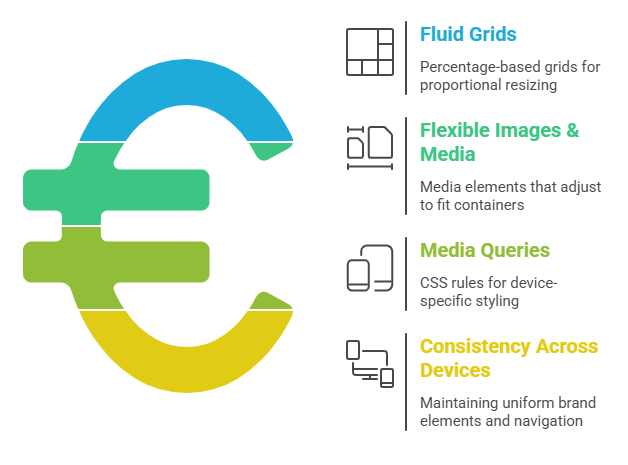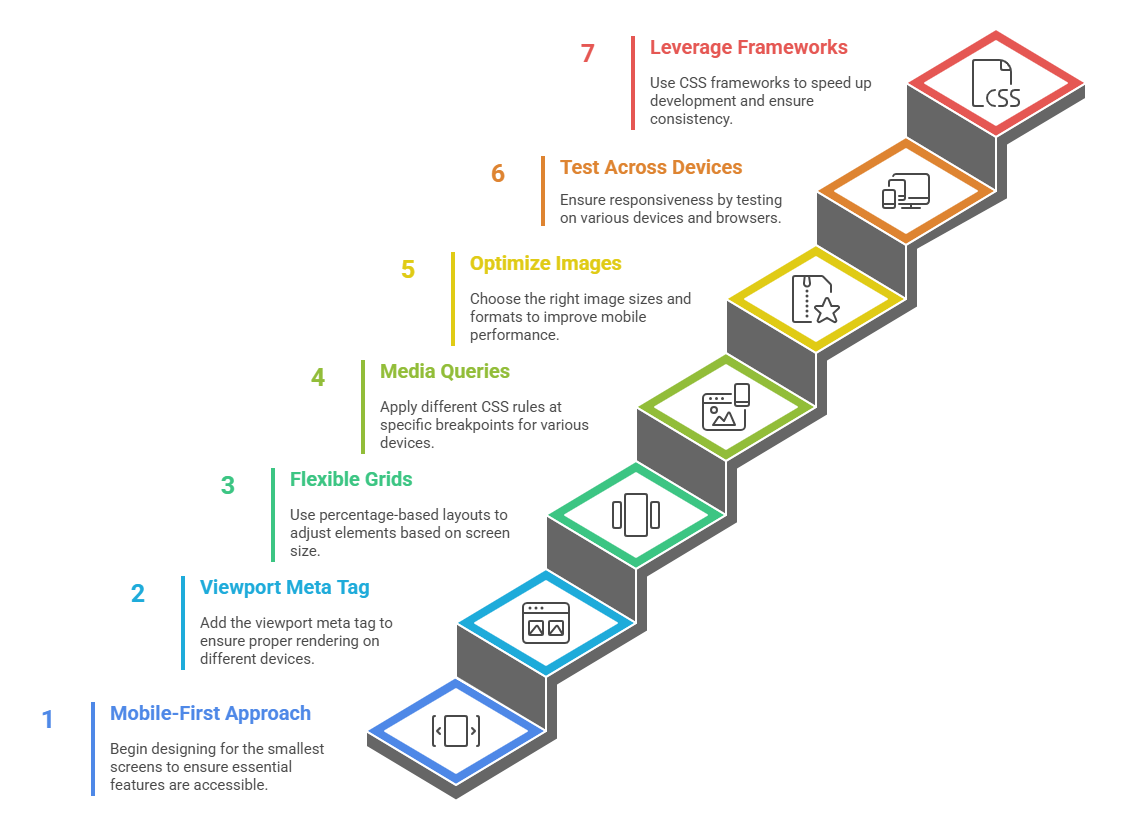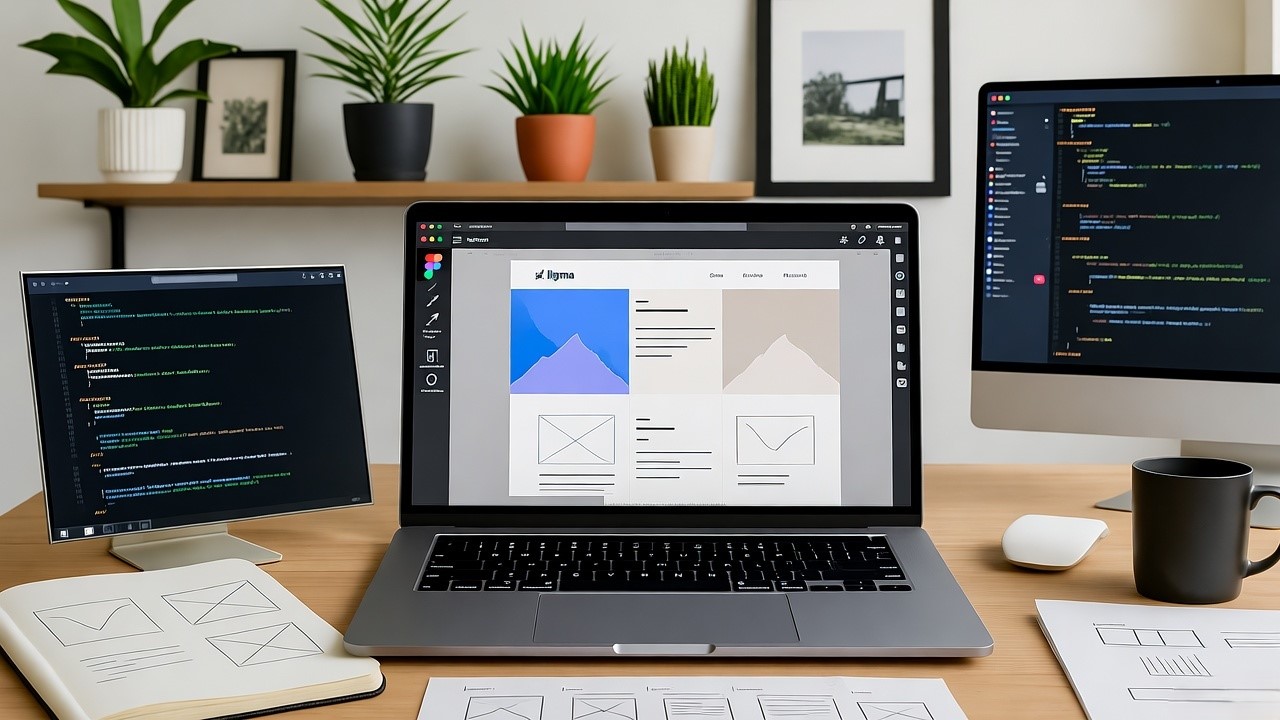Responsive design ensures websites adapt seamlessly to any device, desktop, tablet, or mobile, by adjusting layouts, images, and text fluidly. In today’s mobile-first digital world, responsiveness isn’t optional; it’s essential for accessibility, user experience, and SEO. A responsive page delivers consistency, speed, and engagement across all screens.
A responsive web page automatically adjusts its layout and elements to fit different screen sizes, ensuring readability and usability on desktops, tablets, and smartphones. It’s achieved through flexible grids, fluid images, and CSS media queries. Responsive design improves user experience, accessibility, and search engine ranking.
How to Make a Web Page Responsive
To make a web page responsive, use flexible grid layouts, fluid images, and CSS media queries so elements adapt to different screen sizes. Start with a mobile-first approach, apply relative units instead of fixed ones, and test across devices. This ensures consistent usability and accessibility on desktops, tablets, and smartphones.
What is Responsive Web Design?
Responsive Web Design (RWD) is a modern web development approach that ensures websites deliver an optimal viewing and interaction experience across all devices, whether it’s a desktop, tablet, or smartphone. Instead of building separate versions of a website for each device, responsive design adapts the layout dynamically based on screen size, resolution, and orientation.
This makes browsing seamless for users and reduces design and maintenance overhead for businesses.

Key Principles of Responsive Web Design
Fluid Grids
- Traditional web layouts rely on fixed pixel values, making them rigid and non-adaptive.
- Responsive design uses percentage-based grids, which allow elements to proportionally resize according to the screen width.
- This ensures the structure of the webpage remains consistent, whether on a large desktop monitor or a compact mobile device.
Flexible Images & Media
- Images, videos, and other media elements adjust automatically to fit within their containing elements.
- Instead of overflowing or breaking the layout, flexible media scales proportionally, maintaining clarity without distorting the content.
- Techniques like CSS properties (
max-width: 100%) help keep visuals sharp and aligned without forcing horizontal scrolling.
Media Queries
- Media queries are CSS rules that apply different styles depending on device characteristics like screen width, resolution, or orientation.
- Designers can define breakpoints—specific screen sizes where the layout changes—to deliver device-specific styling.
- For example, a three-column desktop layout can collapse into a single-column stacked view on mobile for easier readability.
Consistency Across Devices
- Responsive design ensures a seamless user experience by maintaining consistent brand elements, typography, and navigation patterns.
- This consistency not only simplifies usability but also boosts SEO, as search engines favor mobile-friendly, responsive websites.
Why Responsive Design Matters for Modern Teams
In today’s fast-paced digital ecosystem, responsive design is more than a design trend, it has become a necessity for modern teams striving to deliver seamless digital experiences. With customers switching between desktops, tablets, and smartphones, businesses that fail to adapt risk losing engagement, search visibility, and even revenue opportunities.
Responsive design ensures consistency, efficiency, and alignment across design, development, and business goals.
Improved User Experience Across Devices
- Responsive design guarantees that users enjoy an optimal viewing experience whether they are on a mobile device, desktop, or tablet.
- Content adjusts fluidly to different screen sizes, reducing friction like awkward scrolling, resizing, or distorted visuals.
- A consistent experience across devices strengthens trust and encourages users to stay longer and engage more deeply.
SEO and Performance Benefits
- Search engines prioritize mobile-friendly websites, making responsive design critical for higher rankings.
- A single responsive site reduces duplicate content issues and supports faster load times, boosting both performance and visibility.
- Optimized performance across devices positively impacts Core Web Vitals, which influence organic search rankings.
Stronger Design–Development Handoffs
- When design systems are responsive, developers encounter fewer translation issues while coding.
- Shared guidelines and adaptable frameworks accelerate collaboration, reducing costly back-and-forth during production.
- This alignment allows teams to move faster from prototypes to live launches.
Business Value and Speed to Market
- A responsive approach supports accessibility standards, ensuring inclusivity for diverse audiences.
- Teams can manage one adaptable codebase instead of creating separate mobile and desktop versions, saving time and costs.
- Faster iterations and simplified workflows translate to quicker product launches and improved time-to-market advantages.
Core Principles of Responsive Design
In today’s digital landscape, users access websites from a wide range of devices, smartphones, tablets, laptops, and large desktop monitors. To provide a consistent and seamless user experience across all these devices, responsive design plays a crucial role. At its core, responsive design ensures that a website layout adapts dynamically to screen sizes, orientations, and resolutions without compromising usability or aesthetics.
Below are the key principles that guide responsive design:
Flexible Layouts
- Websites should not rely on fixed pixel dimensions, as users interact with screens of varying sizes.
- Flexible layouts allow design elements to adjust proportionally, ensuring content retains its visual hierarchy regardless of screen width.
Fluid Grids
- Traditional fixed grids are not practical in responsive environments. Instead, fluid grids scale columns and sections relative to the screen.
- This approach ensures that page structures remain balanced and well-aligned, even when users resize their browser windows.
Relative Units (%, em, rem, vh, vw)
- Using relative units instead of fixed ones (like pixels) provides adaptability. For instance, percentages allow elements to resize in proportion to their container.
- Units like
emandremscale typography based on user preference or root element settings, whilevhandvwrespond to the current viewport size.
Breakpoints and Media Queries
- Breakpoints define specific width ranges where design adjustments should occur—such as repositioning navigation or resizing images.
- Media queries in CSS detect these screen conditions and apply tailored styles to maintain usability and visual appeal.
Mobile-First vs Desktop-First Approaches
- A mobile-first strategy begins with designing for the smallest screen and progressively enhancing the layout for larger devices.
- Desktop-first design starts with the full layout and then simplifies it for smaller devices. Each approach has its use cases, but mobile-first is often preferred in today’s mobile-dominant world.
How to Make a Web Page Responsive: Step-by-Step Guide
Designing a responsive web page ensures your website adapts to different screen sizes, whether it’s being viewed on a mobile device, tablet, laptop, or large desktop monitor. User experience is directly impacted by how well your site adjusts to these varying devices.
Below is a structured step-by-step approach to building responsive web pages that are both user-friendly and future-ready.

Start with a Mobile-First Approach
- Begin by structuring your page for the smallest screens first (like mobile phones) instead of building for desktops and shrinking later.
- This approach ensures essential features and content remain accessible with limited screen space.
- When scaling up for tablets and desktops, you can progressively enhance layouts without overwhelming smaller devices.
- Designing with mobile-first also improves load speed and usability, which matters for SEO ranking and user retention.
Set Up the Viewport Meta Tag
- Add the viewport meta tag in the HTML
<head>section so browsers know how to render your content on different devices. - Without this tag, mobile browsers often shrink pages to fit into a desktop-width container, breaking the experience.
- Example:
<meta name="viewport" content="width=device-width, initial-scale=1.0">ensures the page width matches a device’s width and scales properly.
Use Flexible Grids and Layouts
- Replace fixed-width layouts with percentage-based or relative units (like
em,rem,%) to allow elements to adjust based on screen size. - Employ CSS properties like
max-widthinstead of fixed widths to prevent images and containers from breaking layouts. - Flexible grids (via CSS Grid or Flexbox) give precise control over how elements stack or align on different screen dimensions.
- A fluid layout helps maintain balance between text, images, and whitespace on larger and smaller devices alike.
Apply CSS Media Queries
- Media queries allow different CSS rules to be applied at specific breakpoints, ensuring your design adapts to each screen size.
- Common breakpoints include mobile-first (< 600px), tablets (600px–1024px), and desktops (> 1024px).
- Example:
@media (min-width: 768px) { ... }lets you modify the navigation style for tablets while keeping mobile presentation lightweight. - Media queries provide flexibility so your site looks polished and functional across a range of devices.
Optimize Images and Media
- Large, uncompressed images slow down mobile performance, so always choose the right file size and format.
- Use responsive attributes like
srcsetor CSSbackground-size: coverto serve appropriate images for each screen size. - Consider modern formats such as WebP, which load faster without compromising quality, improving both speed and SEO.
Test Across Devices and Browsers
- Responsiveness isn’t just about screen size; test your page on different operating systems, browsers, and devices.
- Tools like Chrome DevTools or BrowserStack simulate multiple environments, helping spot hidden issues.
- Conduct hands-on testing too, as real devices often reveal design or performance flaws that simulations miss.
Leverage Frameworks and Utilities (Bootstrap, Tailwind, etc.)
- CSS frameworks provide prebuilt responsive grids, classes, and utilities that speed up development and reduce manual coding.
- Tools like Bootstrap or Tailwind CSS ensure consistency across breakpoints while letting you customize for brand-specific needs.
- They cut down on repetitive CSS, allowing you to rapidly design layouts that are responsive by default.
Tools and Frameworks That Streamline Responsive Development
Building modern digital experiences requires far more than just writing lines of CSS. With user expectations evolving and devices becoming increasingly diverse, responsive design has shifted from being an optional best practice to an absolute necessity. To keep development efficient, maintainable, and scalable, developers rely on a range of frameworks, methodologies, and tools that simplify the process of creating layouts that adapt seamlessly across screen sizes.
Below are some of the most widely adopted tools and frameworks that help teams streamline responsive development workflows:
Bootstrap and Foundation for Rapid Prototyping
- Bootstrap and Foundation remain two of the most reliable front-end frameworks for quickly building responsive websites.
- They come with pre-designed grid systems, reusable UI components, and extensive documentation, which cut down development time significantly.
- Both frameworks also support accessibility features and cross-browser compatibility out-of-the-box, ensuring consistency across devices.
- They are particularly useful for teams that need to deliver MVPs or enterprise prototypes without getting stuck in repetitive CSS implementation.
Tailwind CSS and Utility-First Workflows
- Tailwind CSS has redefined modern front-end styling by adopting a utility-first approach, where design is applied through small, composable classes.
- This drastically reduces the need to write custom CSS, while allowing developers to maintain consistency across large codebases.
- Its configuration-driven design system makes it easy to enforce brand guidelines, spacing scales, and responsive breakpoints.
- The framework integrates seamlessly with component libraries in React, Vue, or Angular, making it highly adaptable to different project setups.
CSS Grid and Flexbox for Custom Layouts
- For developers who prefer native CSS over framework abstractions, Grid and Flexbox offer unmatched flexibility.
- CSS Grid is ideal for building complex two-dimensional layouts, while Flexbox excels at arranging content in one dimension.
- Together, they can be combined to create adaptive, lightweight, and highly customized layouts without relying on bulky framework code.
- Since both are well supported across modern browsers, they reduce the dependency on polyfills or heavy CSS resets.
Figma-to-Code Integrations
- Modern design-to-code solutions now enable rapid handoff from tools like Figma to frameworks such as React, Angular, or Vue.
- These integrations reduce friction between design and development by auto-generating components that are responsive-ready.
- While not a complete replacement for manual coding, they accelerate the initial build phase and help maintain design consistency.
- This approach also enhances collaboration between designers and developers, ensuring fewer layout discrepancies.
Responsive Testing Tools
- Tools like Chrome DevTools and BrowserStack are essential for verifying how applications perform across different devices and screen sizes.
- Chrome DevTools allows developers to simulate responsiveness directly in the browser, adjusting breakpoints and testing device-specific resolutions.
- BrowserStack goes further by enabling live testing on real devices and across multiple browsers, ensuring that designs work beyond emulated environments.
- These tools help teams catch issues such as layout overflow, touch target sizing, and inconsistent spacing before deployment.
Best Practices for Teams Working with Figma-to-Code Pipelines
As more organizations adopt Figma-to-code workflows, aligning design and development processes becomes critical. The goal is not only to translate beautiful mockups into functioning applications but also to ensure consistency, scalability, and maintainability across breakpoints and frameworks.
For teams working within modern front-end ecosystems like React, Angular, or Vue, the following best practices can help streamline collaboration and deliver high-quality user interfaces.
Ensure design consistency across breakpoints
- Define responsive grids, spacing rules, and typographic scales in Figma early, so developers can apply them directly without reinventing breakpoints.
- Use auto-layout and constraint-based design features in Figma to preview how elements will adapt across desktop, tablet, and mobile.
- Document tokenized values (e.g., font sizes, spacing units, primary colors) in a design system, ensuring developers can map them easily into CSS or framework-specific styles.
Adopt a component-driven design approach
- Structure Figma components to mirror the hierarchy of UI components in React, Angular, or Vue, making the handoff more intuitive.
- Apply atomic design principles, breaking down interfaces into buttons, inputs, and cards before scaling up into full-page templates.
- Encourage reusable components in both design and code, reducing redundancy and increasing maintainability of the UI library.
Maintain performance and clean CSS standards
- Avoid unnecessary visual effects or deeply nested layers in Figma, since they can lead to inefficient CSS output.
- Establish naming conventions for classes or utility styles to keep the generated code modular and readable.
- Regularly audit CSS bundles to remove unused styles, ensuring lean performance without bloated style sheets.
Enable collaborative handoff between designers and developers
- Utilize design tokens extracted directly from Figma for color palettes, spacing, and typography to reduce translation errors.
- Conduct joint reviews of complex components, so both teams align on intended behavior before development begins.
- Encourage feedback loops throughout the sprint cycle, rather than leaving interactions or animations open to interpretation.
By integrating these practices, teams can optimize their Figma-to-code pipelines, delivering products that look consistent, perform efficiently, and remain scalable across evolving frameworks.
Common Mistakes in Responsive Web Design
Responsive web design is essential for delivering a seamless user experience across desktops, tablets, and smartphones. However, many businesses and developers make mistakes during the design process that limit usability, accessibility, and performance. Avoiding these pitfalls can improve both engagement and conversion.
Below are some of the most common mistakes you should look out for:
Overusing Fixed Units Instead of Flexible Measurements
- Designers often rely heavily on fixed pixel values, which can restrict elements from adjusting naturally on varying screen sizes.
- Using responsive units like percentages,
em,rem, and viewport-based measurements allows layouts to adapt smoothly without cutting off content.
Poor Breakpoint Planning
- Many websites focus only on popular screen sizes and neglect intermediate breakpoints, resulting in awkward layouts on less common devices.
- A better practice is to analyze user analytics, identify the most used screen resolutions, and plan breakpoints based on actual data rather than assumptions.
Ignoring Accessibility Standards
- Responsiveness often addresses screen adaptability but overlooks inclusivity, such as proper contrast, readable font sizes, and keyboard-friendly navigation.
- Designing with accessibility in mind ensures the site is usable for people with disabilities while also improving overall usability for all users.
Neglecting Real Device Testing
- Relying only on browser resizing or simulators does not fully represent how a site behaves on actual smartphones or tablets.
- Testing on multiple real devices helps identify performance gaps, touch responsiveness issues, and orientation problems that simulators may miss.
Advanced Tips for Performance and Optimization
When it comes to modern front-end development, optimizing both performance and flexibility is just as critical as delivering great visuals. Developers now have a rich set of CSS and browser-native techniques to build responsive and efficient experiences without relying heavily on polyfills or third-party utilities.
Below are some advanced practices that can elevate your projects.
Responsive typography with clamp()
- The
clamp()function allows developers to create fluid typography that automatically scales between a defined minimum and maximum value. - This eliminates the need for complex media queries while ensuring legibility across mobile, tablet, and desktop devices.
- By combining relative units like
vw(viewport width) with fixed limits inpxorrem, designers can maintain visual hierarchy without text becoming oversized or too small.
Lazy loading images and videos
- Implementing native
loading="lazy"on images orposterattributes for videos delays the loading of non-critical media until they are about to enter the viewport. - This improves initial page load time, reduces Time to Interactive (TTI), and leads to better Core Web Vitals scores.
- For heavier video assets, combining lazy loading with responsive formats (e.g., WebP, AVIF, or adaptive streaming) ensures that performance remains consistent even on slower connections.
Leveraging container queries
- Container queries are one of the most transformative additions to modern CSS, enabling styles to adapt to the size of a parent container rather than just the viewport.
- This allows components to remain reusable and context-aware, adjusting dynamically when placed in sidebars, cards, or multi-column layouts.
- By moving away from layout-dependent media queries, developers gain more control over modular, component-driven design systems.
Hybrid layout strategies with CSS Grid and Flexbox
- CSS Grid excels at defining two-dimensional layouts with precise placement, while Flexbox is ideal for one-dimensional alignment and distribution.
- Combining both allows developers to build complex structures, such as grids for page sections and flex-based alignment for navigation or content within each section.
- This hybrid approach ensures greater adaptability, reduces the need for hacky layout workarounds, and provides a clean separation between macro layouts and micro content alignment.
What's Next
Responsive design is the backbone of modern digital products, ensuring accessibility, consistency, and performance across every device. In a landscape where users shift fluidly between screens, responsiveness builds trust and keeps engagement high. Beyond aesthetics, it improves SEO, usability, and overall brand perception. Streamlined workflows, from design to code, make responsiveness more efficient to implement, allowing teams to focus on innovation while delivering seamless, future-ready experiences that meet user expectations anywhere, anytime.




